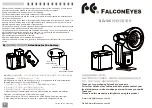
clockwise direction. However, to let off
tensions, you must disengage the pawls
from the ratchets.
In most cases, you'll be adding tension
to speed up the blades. Rotating the
opening-blade ratchet one click-stop in a
clockwise direction increases the travel
time by around 0.1ms. An increase of one
click-stop on the closing-blade ratchet
provides around a 0.2ms increase in the
travel time.
It's a little more d ifficult to let o ff ten
sion. Probably the easiest way is to simply
disengage the appropriate spring pawl
and allow the drive spring to completely
unwind (around 1/2 turn). Then build up
the tension from scratch.
Checking the travel times w ith the
shutter removed presents another prob
lem — it's awkward to hold the probe
behind the blades as you operate the
shutter. However, as you'll see in a mo
ment, you can visually set the ratchets
very close to the proper positions. You
can then replace the shutter. Even w ith
the shutter installed on the mirror cage,
you can reach the tension-setting rat
chets, Fig. 87.
Temporarily seat the front-plate/mirror-
cage assembly in the body casting. Then,
with the speed selector set at the
1/1000-second mechanical speed, measure
the blade-travel times. Remembering the
amount of correction you need, pull the
front-plate/mirror-box assembly and make
the adjustments. Suppose, for example,
that you measure an opening-blade travel
time of 6.2ms. You now know that you
must add two clicks of tension to the
opening-blade ratchet.
REPAIRS IN THE CONTROL
SECTION OF THE SEIKO
Other than cleaning the blades, there
aren't many common repairs in the Seiko
shutters. If you're getting overexposures
at high-light levels and fast manual
speeds, try cleaning the surfaces of the
electromagnet core and armature, Fig.
82. Oil on the interface causes sticking.
As a result, the electromagnet can't
release its armature quickly enough.
Also, you'll occasionally find that force
has sheared o ff one of the pins in the
shutter — either the pin on the shutter-
cocking lever or the pin on the opening-
blade driving lever. If you can find the
missing pin, you can restake it to the
lever. Otherwise, you'll have to replace a
part.
Complete shutter disassembly does
disturb some adjustment points. For one,
you must let off the blade tensions. Also,
you'll lose the initial tension on the timing
cam. Fig. 86.
During the cocking cycle, the shutter-
cocking lever rotates the timing cam in a
clockwise direction. A cam ridge on the
tim ing cam then allows the trigger switch
to close. Also, the timing cam pushes the
armature against the electromagnet, Fig.
82. A t the end of the cocking stroke, the
release lever latches the timing cam.
Disengaging the release lever frees the
timing cam. A spring then drives the tim
ing cam in a counterclockwise direction.
The timing cam both releases the opening
blade and drives open the trigger switch.
The spring w hich drives the timing cam
connects to a spring-hooking tab on the
bridge plate. Fig. 84. In the first Seiko
shutters, such as the model illustrated,
the spring-hooking tab is a separate
piece. A screw holds the spring-hooking
tab to the bridge plate.
A fter loosening the screw, you can
rotate the spring-hooking tab to change
the tension. Increasing the spring tension
by turning the spring-hooking tab
counterclockwise causes the timing cam
to rotate faster. The result? A significant
change in the fast speeds.
But d o n 't use the spring-hooking tab as
a shutter-speed adjustment. Rather, on
reassembly, simply return the spring-
hooking tab to its original position, Fig.
84. Notice that Seiko uses a locking agent
on the spring-hooking tab and screw. If
the screw works loose, the tim ing cam
loses its spring tension. Consequently,
the shutter w o n 't release. In later shut
ters, Seiko made the spring-hooking tab
part of the bridge plate.
If you don 't change the initial tension
on the timing-cam spring — and if you
avoid disturbing the trigger-switch eccen
tric — you may find that you d o n 't have
to adjust 1/1000 second. You can also
visually set the blade tensions according
to the positions of the ratchets, Fig. 84.
Returning the ratchets to their proper
positions often brings in the blade-travel
times w itho u t further adjustment.
On reassembly, rotate the ratchets
clockwise to apply the initial tensions.
Locate the spring-hooking slots in the
sides of the ratchets. Rotate the closing-
blade ratchet until its spring-hooking slot
just reaches the edge of the bridge plate.
Fig. 88. Then rotate the opening-blade
ratchet until its spring-hooking slot just
passes the bridge-plate cutout.
Here's another shutter problem you
may encounter — the blades w o n 't stay
in the cocked position. First check the
spring on the release lever. Fig. 84. If the
spring comes disconnected, the release
lever w o n 't latch the timing cam. As a re
sult, the blades w o n 't latch in the cocked
position — the timing cam immediately
releases the opening blade. There should
be a dab of Pliobond between the end of
the spring and the release lever.
DISASSEMBLY OF THE
SEIKO SHUTTER
Locate the tw o electromagnet lead
wires w hich connect to the shutter-
terminal board. Fig. 82. Both wires are
the same color — normally white, but
sometimes green or red. Unsolder both
wires. Also unsolder the end of the trig
ger switch from the shutter-circuit board.
Fig. 82. You'll probably find that it's
easier to unsolder the trigger switch as
you lift the shutter-terminal board from
the bridge plate.
Remove the screw and lift o ff the
shutter-terminal board. On the back of
the shutter-terminal board, you can see
the X-sync contact. The lever w hich
disengages the mechanical-speed latch
for the mechanical 1/100-second ex
posure also strikes the X-sync contact to
fire the flash.
Now disengage the spring pawls to let
o ff the blade tensions. Also loosen the
screw which holds the spring-hooking
tab, Fig. 84. A llow the timing-cam spring
to rotate the spring-hooking tab in a
clockwise direction. Then remove the
screw and lift out the spring-hooking tab.
If you're working on a later version of the
shutter, just disconnect the timing-cam
spring from the tab on the bridge plate.
To replace the spring-hooking tab, first
locate the end of the timing-cam spring.
Seat the spring-hooking tab clockwise of
the spring end. Then replace the screw.
Before you tighten the screw, rotate the
spring-hooking tab counterclockwise to
the position shown in Fig. 84.
There are tw o more springs to discon
nect before you remove the bridge plate.
Disconnect the armature spring from the
bridge-plate tab, Fig. 86, and disconnect
the spring from the release lever. Fig. 84.
N ow remove the remaining bridge-plate
screws.
















































